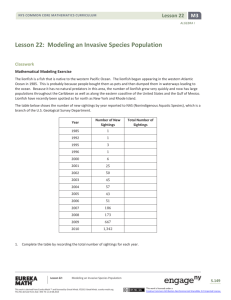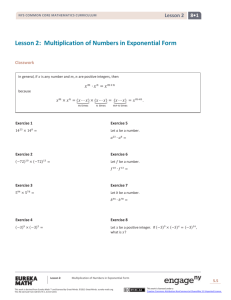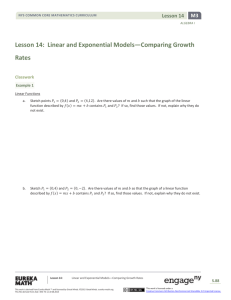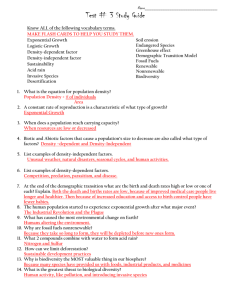Algebra I Module 3, Topic D, Lesson 22: Teacher Version
advertisement
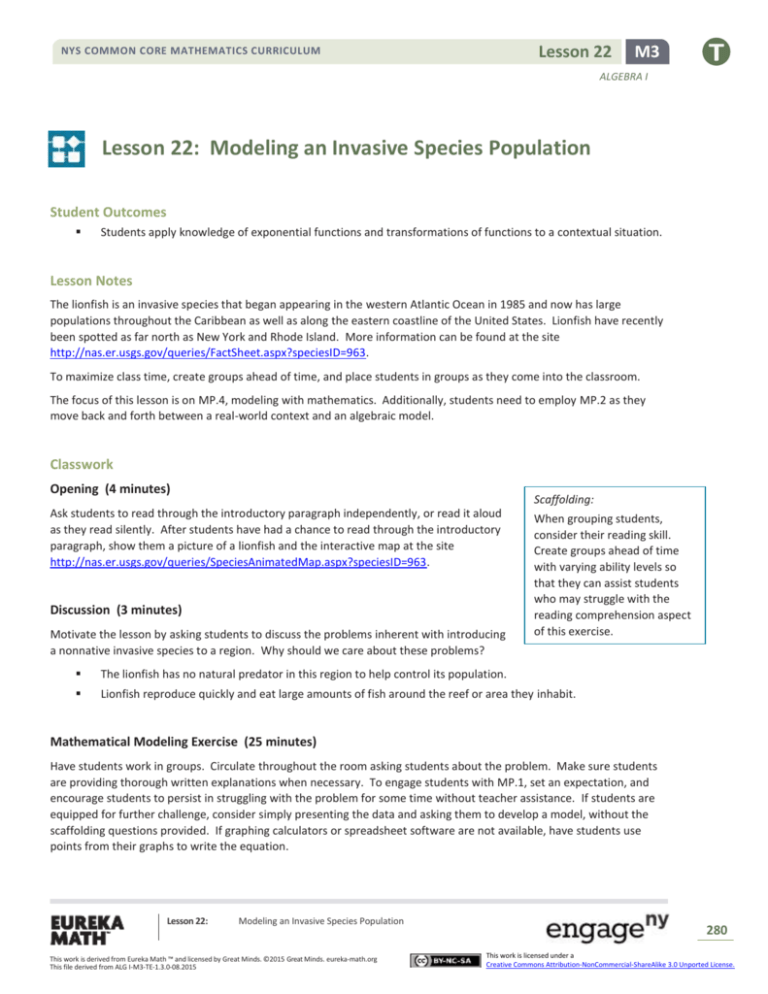
Lesson 22 NYS COMMON CORE MATHEMATICS CURRICULUM M3 ALGEBRA I Lesson 22: Modeling an Invasive Species Population Student Outcomes Students apply knowledge of exponential functions and transformations of functions to a contextual situation. Lesson Notes The lionfish is an invasive species that began appearing in the western Atlantic Ocean in 1985 and now has large populations throughout the Caribbean as well as along the eastern coastline of the United States. Lionfish have recently been spotted as far north as New York and Rhode Island. More information can be found at the site http://nas.er.usgs.gov/queries/FactSheet.aspx?speciesID=963. To maximize class time, create groups ahead of time, and place students in groups as they come into the classroom. The focus of this lesson is on MP.4, modeling with mathematics. Additionally, students need to employ MP.2 as they move back and forth between a real-world context and an algebraic model. Classwork Opening (4 minutes) Scaffolding: Ask students to read through the introductory paragraph independently, or read it aloud as they read silently. After students have had a chance to read through the introductory paragraph, show them a picture of a lionfish and the interactive map at the site http://nas.er.usgs.gov/queries/SpeciesAnimatedMap.aspx?speciesID=963. Discussion (3 minutes) Motivate the lesson by asking students to discuss the problems inherent with introducing a nonnative invasive species to a region. Why should we care about these problems? When grouping students, consider their reading skill. Create groups ahead of time with varying ability levels so that they can assist students who may struggle with the reading comprehension aspect of this exercise. The lionfish has no natural predator in this region to help control its population. Lionfish reproduce quickly and eat large amounts of fish around the reef or area they inhabit. Mathematical Modeling Exercise (25 minutes) Have students work in groups. Circulate throughout the room asking students about the problem. Make sure students are providing thorough written explanations when necessary. To engage students with MP.1, set an expectation, and encourage students to persist in struggling with the problem for some time without teacher assistance. If students are equipped for further challenge, consider simply presenting the data and asking them to develop a model, without the scaffolding questions provided. If graphing calculators or spreadsheet software are not available, have students use points from their graphs to write the equation. Lesson 22: Modeling an Invasive Species Population This work is derived from Eureka Math ™ and licensed by Great Minds. ©2015 Great Minds. eureka-math.org This file derived from ALG I-M3-TE-1.3.0-08.2015 280 This work is licensed under a Creative Commons Attribution-NonCommercial-ShareAlike 3.0 Unported License. Lesson 22 NYS COMMON CORE MATHEMATICS CURRICULUM M3 ALGEBRA I Why did you decide the data was linear or exponential? Did seeing the scatter plot change your mind? What do you think the graph will look like in the future? Will it keep going up? Level off? Why? Mathematical Modeling Exercise The lionfish is a fish that is native to the western Pacific Ocean. The lionfish began appearing in the western Atlantic Ocean in 1985. This is probably because people bought them as pets and then dumped them in waterways leading to the ocean. Because it has no natural predators in this area, the number of lionfish grew very quickly and now has large populations throughout the Caribbean as well as along the eastern coastline of the United States and the Gulf of Mexico. Lionfish have recently been spotted as far north as New York and Rhode Island. The table below shows the number of new sightings by year reported to NAS (Nonindigenous Aquatic Species), which is a branch of the U.S. Geological Survey Department. Year 1985 1992 1995 1996 2000 2001 2002 2003 2004 2005 2006 2007 2008 2009 2010 Number of New Sightings 𝟏 𝟏 𝟑 𝟏 𝟔 𝟐𝟓 𝟓𝟎 𝟒𝟓 𝟓𝟕 𝟒𝟑 𝟓𝟏 𝟏𝟖𝟔 𝟏𝟕𝟑 𝟔𝟔𝟕 𝟏, 𝟑𝟒𝟐 Total Number of Sightings 𝟏 𝟐 𝟓 𝟔 𝟏𝟐 𝟑𝟕 𝟖𝟕 𝟏𝟑𝟐 𝟏𝟖𝟗 𝟐𝟑𝟐 𝟐𝟖𝟑 𝟒𝟔𝟗 𝟔𝟒𝟐 𝟏, 𝟑𝟎𝟗 𝟐, 𝟔𝟓𝟏 1. Complete the table by recording the total number of sightings for each year. 2. Examine the total number of sightings data. Which model appears to be a better fit for the data—linear or exponential? Explain your reasoning. Exponential. For example, the total number of sightings appears to have doubled each of the last three years. Lesson 22: Modeling an Invasive Species Population This work is derived from Eureka Math ™ and licensed by Great Minds. ©2015 Great Minds. eureka-math.org This file derived from ALG I-M3-TE-1.3.0-08.2015 281 This work is licensed under a Creative Commons Attribution-NonCommercial-ShareAlike 3.0 Unported License. Lesson 22 NYS COMMON CORE MATHEMATICS CURRICULUM M3 ALGEBRA I 3. Make a scatter plot of the year versus the total number of sightings. 4. Based on the scatter plot, either revise your answer from Exercise 2 or explain how the scatter plot supports your answer from Exercise 2. Answers will vary. If students responded in Exercise 2 that an exponential model would be a better fit, then the scatter plot supports their initial response since the data points appear to form an exponential curve. If students responded that a linear model would be a better fit, then they should revise their initial response to say that an exponential model would be better for this data since the scatter plot looks like an exponential curve. 5. On the scatter plot, draw a smooth curve that best fits the data. The smooth curve should look similar to the above scatter plot. 6. From your table, calculate the average rate of change in the total number of sightings for each of the following time intervals. a. 1995–2000 𝟏. 𝟒 7. b. 2000–2005 c. 𝟒𝟒 2005–2010 𝟒𝟖𝟒 How do the average rates of change help to support your argument of whether a linear or an exponential model is better suited for the data? If the model total number of sightings was growing linearly, then the average rate of change would be constant. Instead, it appears to be growing multiplicatively, indicating an exponential model. Lesson 22: Modeling an Invasive Species Population This work is derived from Eureka Math ™ and licensed by Great Minds. ©2015 Great Minds. eureka-math.org This file derived from ALG I-M3-TE-1.3.0-08.2015 Scaffolding: This lesson could be extended to a student project. Early finishers could work on researching other nonnative invasive species found in the U.S. 282 This work is licensed under a Creative Commons Attribution-NonCommercial-ShareAlike 3.0 Unported License. NYS COMMON CORE MATHEMATICS CURRICULUM Lesson 22 M3 ALGEBRA I 8. Use the regression feature of a graphing calculator to find an equation that models the number of lionfish sightings each year. Answers will vary depending on the technology used. If the selected technology is not sensitive enough to display the equation for the exponential model, provide students with the equation below. Let 𝒙 represent the year. Exponential model: 𝒚 = (𝟒. 𝟔𝟎𝟐 × 𝟏𝟎−𝟐𝟗𝟐 )(𝟏. 𝟒𝟎𝟏)𝒙 Linear model: 𝒚 = 𝟔𝟏. 𝟏𝟓𝒙 − 𝟏𝟐𝟐 𝟎𝟎𝟎 Bivariate Data Points 𝒚 = (𝟒. 𝟔𝟎𝟐 × 𝟏𝟎−𝟐𝟗𝟐 )(𝟏. 𝟒𝟎𝟏)𝒙 𝒚 = 𝟔𝟏. 𝟏𝟓𝒙 − 𝟏𝟐𝟐 𝟎𝟎𝟎 Lesson 22: Modeling an Invasive Species Population This work is derived from Eureka Math ™ and licensed by Great Minds. ©2015 Great Minds. eureka-math.org This file derived from ALG I-M3-TE-1.3.0-08.2015 283 This work is licensed under a Creative Commons Attribution-NonCommercial-ShareAlike 3.0 Unported License. Lesson 22 NYS COMMON CORE MATHEMATICS CURRICULUM M3 ALGEBRA I 9. Use your model to predict the total number of lionfish sightings by the end of 2013. Exponential: 𝟐, 𝟕𝟕𝟑 total sightings Linear: 𝟏, 𝟎𝟗𝟓 total sightings 10. The actual number of sightings as of July 2013 was 𝟑, 𝟕𝟕𝟔. Does it seem that your model produced an accurate prediction? Explain. Answers will vary. See the Closing below. Closing (8 minutes) After students have completed the problem, discuss the following: Which model would be a better fit for the data―linear or exponential? Why? What do you think the graph will look like in the future? Will it keep going up? Level off? Why? Exponential. The rate of change was not constant, which would make it linear. The average rates of change got progressively larger. The graph had the basic shape of an exponential growth curve. Answers will vary. Was your model accurate in predicting the number of sightings for 2013? If students used the graphing calculator to find the equation, the prediction is pretty close (3,147– 3,307), but it does underestimate the actual number, especially considering that the number is only for the first half of 2013. If students did not use a graphing calculator, their answers will vary. Compare several equations. Could your model accurately predict the future number of sightings? What are the possible implications if the number continues to increase exponentially? Answers will vary. The population will become so large that it will threaten other marine life, especially around coral reefs. Exit Ticket (5 minutes) Lesson 22: Modeling an Invasive Species Population This work is derived from Eureka Math ™ and licensed by Great Minds. ©2015 Great Minds. eureka-math.org This file derived from ALG I-M3-TE-1.3.0-08.2015 284 This work is licensed under a Creative Commons Attribution-NonCommercial-ShareAlike 3.0 Unported License. NYS COMMON CORE MATHEMATICS CURRICULUM Lesson 22 M3 ALGEBRA I Name ___________________________________________________ Date____________________ Lesson 22: Modeling an Invasive Species Population Exit Ticket 1. For the equation found in Exercise 8, explain the parameters of the equation within the context of the problem. 2. Given each of the following, describe what features in the data or graph make it apparent that an exponential model would be more suitable than a linear model. 3. a. The table of data b. The scatter plot c. The average rates of change found in Exercise 6 Use your equation from Exercise 8 to predict the number of lionfish sightings by year 2020. Is this prediction accurate? Explain. Lesson 22: Modeling an Invasive Species Population This work is derived from Eureka Math ™ and licensed by Great Minds. ©2015 Great Minds. eureka-math.org This file derived from ALG I-M3-TE-1.3.0-08.2015 285 This work is licensed under a Creative Commons Attribution-NonCommercial-ShareAlike 3.0 Unported License. Lesson 22 NYS COMMON CORE MATHEMATICS CURRICULUM M3 ALGEBRA I Exit Ticket Sample Solutions 1. For the equation found in Exercise 8, explain the parameters of the equation within the context of the problem. 𝒂 = 𝟒. 𝟔𝟎𝟐 × 𝟏𝟎−𝟐𝟗𝟐, at 𝒙 = 𝟎; there were virtually no lionfish in the Atlantic Ocean. 𝒃 = 𝟏. 𝟒𝟎𝟏; the population of lionfish grew by this constant quotient of change every year. 2. Given each of the following, describe what features in the data or graph make it apparent that an exponential model would be more suitable than a linear model. a. The table of data The values of the lionfish sightings grow by a quotient of change rather than a constant rate of change. b. The scatter plot The shape of the scatter plot looks more like an exponential curve than a line. c. The average rates of change found in Exercise 6 The three sets of average rates of change would have been the same, or close to the same, had the situation been more suited to a linear model. 3. Use your equation from Exercise 8 to predict the number of lionfish sightings by year 2020. Is this prediction accurate? Explain. 𝟐𝟗, 𝟑𝟕𝟓 This answer assumes that the conditions that allowed for a constant quotient of change remain the same until 2020. This is probably not a realistic scenario; change in ocean temperature, food availability, and other needs for continued exponential growth would have to remain the same to yield this projected population. Problem Set Sample Solutions Another Invasive Species Problem: Kudzu Kudzu, a perennial vine native to Southeast Asia, now covers a large area of the southern United States. Kudzu was promoted as a forage crop and an ornamental plant when it was introduced to the U.S. at the Philadelphia Centennial Exposition in 1876. Many southern farmers were encouraged to plant kudzu for erosion control from the mid-1930s to the mid-1950s. In 1953, kudzu was removed from the U.S. Department of Agriculture’s list of permissible cover plants due to its recognition as an invasive species. Look up information about kudzu in the U.S. on Wikipedia, and write a short (1- to 2-page) report on the growth of kudzu since its introduction. In your report, choose a function (linear or exponential) to model and graph the growth of kudzu (in hectares) in the U.S. per year over the past half century or so. Remember to cite your sources! To the teacher: Point out that the report is not about getting a correct answer but how they explain and manipulate the data that they find. Hence, it is important for them to cite their sources. (Note: A rough estimate of how kudzu spreads, 𝟓𝟎, 𝟎𝟎𝟎 hectares per year, is on the Wikipedia page—challenge them to find out more than that.) Lesson 22: Modeling an Invasive Species Population This work is derived from Eureka Math ™ and licensed by Great Minds. ©2015 Great Minds. eureka-math.org This file derived from ALG I-M3-TE-1.3.0-08.2015 286 This work is licensed under a Creative Commons Attribution-NonCommercial-ShareAlike 3.0 Unported License.
